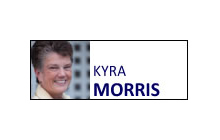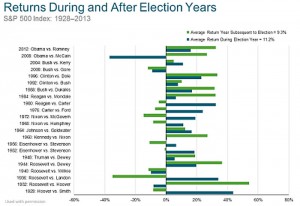By Kyra Morris, contributing editor | This is an election year, and often we hear that election years are bad years for market returns. This is a particularly interesting, unusual and unexpected election year. The markets are jittery. What though really is the correlation of election years and the subsequent years to market returns?
 Before I present the data that shows every presidential election since 1928 and the returns of the Standard & Poor’s (S&P) 500 Index both during and subsequent to the election year, let’s see how you do on some election and presidential trivia. See what you can do to answer these questions without peaking. The answers are given after all the questions:
Before I present the data that shows every presidential election since 1928 and the returns of the Standard & Poor’s (S&P) 500 Index both during and subsequent to the election year, let’s see how you do on some election and presidential trivia. See what you can do to answer these questions without peaking. The answers are given after all the questions:
- During which year of a US Presidential election did the S&P 500 Index have the highest return?
- a) 1928, Hoover vs. Smith
- b) 1960, Kennedy vs. Nixon
- c) 1980, Reagan vs. Carter
- d) 2004, Bush vs. Kerry
2. During how many four-year presidential terms was the cumulative return of the S&P negative?
- a) 1 b) 2 c) 4 d). 7
3. What is the highest return for the Barclay’s Aggregate Bond Index during an election year? The Barclay’s Aggregate Bond Index is an index for domestic bonds similar to the way the S&P 500 Index is an index for domestic stocks.
- a) Carter vs. Ford, 1976
- b) Reagan vs. Carter, 1980
- c) Bush vs. Gore, 2000
4. How many years since 1928 did the S&P 500 Index experience a negative year during an election year?
- a) 6 b) 3 c) 4 d) 12
5. How many years since 1928 did the S&P 500 Index experience a negative return subsequent to an election year?
- a) 10 b) 4 c) 12 d) 6

Now we get to look at the answers. I took this quiz also and my response was, “Geez, I can’t even manage the past, how can I predict the future?”
- The answer is A: 1928, Hoover vs. Smith with 43.6 percent. The others are 1960 Nixon vs. Kennedy with 0.5 percent, 1980 Reagan vs. Carter with 32.4 percent, and 2004 Bush vs. Kerry with 10.9 percent. Overall the average returns during all election years are 11.2 percent.
- The answer is C: Only four presidential terms had a cumulative negative return. One President had two negative terms. These terms were Hoover from ’29 to’32, FD Roosevelt from ’37 to’40, GW Bush from ’01 to 04 and GW Bush from ’05 to 08.
- The answer is A: Carter vs. Ford, 1976 had a 15.6 percent return. Reagan vs. Carter, 1980 had a 2.7 percent return, and GW Bush vs. Gore, 2000 had an 11.6 percent return. There have never been any negative returns for the Barclay’s Aggregate Index during election years. This question is a reflection on interest rates. As interest rates rise the Barclay’s Aggregate Bond Index returns should drop and as interest rates fall the returns should increase. Therefore, the question is potentially asking for a period when interest rates fell the most.
- The answer is C. There have been only four years since 1928 when the returns during an election year were negative. There were most recently Obama vs. McCain in 2008 and Bush vs. Gore in 2000. Before that we have to go back to 1940 with Roosevelt vs. Dewey and 1932 with Roosevelt vs. Hoover.
- The answer is A. There were 10 years of negative returns during the year subsequent to an election. The years were GW Bush in 2001, Reagan in 1981, Carter in 1977, Nixon in 1969 and 1973, Eisenhower in 1953 (just barely negative) and 1957, FD Roosevelt in 1937 and 1941, and Hoover in 1929.
There are many speculations and myths about election years. The truth is that it is difficult to identify systematic return patterns both during and subsequent to an election year. The pattern is primarily positive for both years during and after the election.
This is an election year, and January started with the worst returns for the S&P 500 Index since 2009. Does that along with the fact that it is an election year mean that S&P 500 Index returns in 2016 will be abysmal? I am not sure. I guessed a lot more negative in the past than the facts showed. How many of the above questions did you get right?



 We Can Do Better, South Carolina!
We Can Do Better, South Carolina!
























